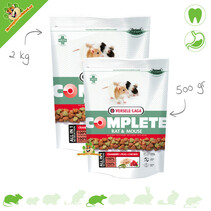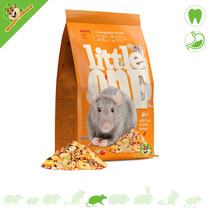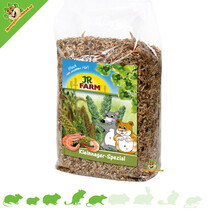Rat food for the Rats in the Rats Webshop!
- Voor 17 uur besteld morgen in huis!*
- Persoonlijk & deskundig advies
- Al 13 jaar een begrip!

You can order rat food easily and quickly at DRD Knaagdierwinkel® , the Rat Webshop for your Rat!
You can buy rat food for your rats easily and quickly at DRD Rodent Shop. Do you want to spoil your Rats with healthy, balanced rat food? Then you've come to the right place! Choose from different brands and types of rat food for an attractive price. Little One, Mixerama, Versele-Laga, Witte Molen, Supreme, etc. Ordering is always quick and easy in our Ratten webshop.
What do rats eat?
The Rat is a small, omnivorous mammal. This means that the Rat is an omnivore; it feeds on a variety of foods. It belongs to the order of rodents and is very social. In nature it often lives in groups of up to 100 animals. Its life expectancy is about 4 years and it reaches a body length of 28 cm and a weight of 270 to 400 g.
What do Rats eat in the wild?
The current black rat is descended from the brown rat. It originally lived on the mainland in southeastern Siberia, Mongolia and northeastern China. In the wild, the Brown Rat exhibits both territorial and colonial behavior and typically occupies underground burrows. Nowadays the Rat can be found almost all over the world. In the tropics and subtropics it only lives in cities. Also in Europe and North America it often lives near people and buildings and feels particularly good in partition walls or old drain pipes. Rats in the wild often live near water. The Rat has its own nutritional needs.
What does the rat's digestion look like?
Apart from the lack of a gallbladder, the rat's digestive tract resembles that of other omnivorous rodents in that the stomach contains both non-glandular and glandular regions, the small intestine is of medium length, and the cecum is relatively well developed.
Can Rats handle fiber?
The addition of fiber (cellulose) to diets containing natural ingredients reduces energy digestibility in rats. This means that rats are then less able to extract nutrients from fiber. Although 15 to 60% of the fiber is digested.
Are Rats Omnivores by Nature?
Rats are omnivores by nature. Characteristic of the rat's digestive system are its lifelong incisors, molars that do not grow further, a relatively short cecum and a high need for easily digestible carbohydrates. The incisors are worn down because they continue to grow. This wear occurs, among other things, by breaking open seeds or gnawing on larger food components. In addition, gnawing wood must always be offered.
Protein: Rats need animal proteins, which are essential for metabolism. The protein content in the diet should be between 12 and 15%. A protein deficiency in rats can have major consequences such as growth retardation, edema formation, muscle breakdown, weight loss and anemia.
Fiber: Rats have a fast metabolism and therefore need energy-rich food with easily digestible carbohydrates. The fiber content in rat food should therefore not be too high.
Fat: The fat content in the diet should not exceed 5%. Rats often have a predisposition to quickly develop obesity. However, fat is a very important part of the Rat's diet, because it provides essential fatty acids (EFA) and a concentrated source of energy, and fat also aids in the absorption of fat-soluble vitamins.
Calcium: The calcium:phosphorus ratio in a rat's diet should be between 1.1:1 and 1.5:1. Calcium is important for the teeth and skeleton.
Incisors: These continue to grow, so the food must provide the necessary tooth wear. Hardness, size and type of food are important.
Stomach: The stomach consists of one chamber and is separated by a mucous membrane into a part without a gland and a part with a gland.
Small Appendix: Rats have a small appendix. As a result, they can only process raw fibers to a limited extent. Therefore, feed with a crude fiber content of less than 10% is optimal.
Animal proteins: Omnivorous (omnivorous) animals need animal proteins. The valuable amino acids are important for cell renewal and various metabolic processes.
Increased energy requirement: The fast animals have a higher metabolism and therefore a special energy requirement.
Temperature, age and activity influence the rat's energy needs.
Feeding rats with a twist
Rats are very intelligent animals and they love to be busy. We think of all kinds of things for them so that they don't get bored, but we often forget to include the food! We call enriching the diet 'feeding with a twist' and we are happy to tell you how you can do that!
Rats are not only highly intelligent, but also agile and social. This is reflected in their everyday behavior in the enclosure. They communicate with each other, play and sleep together. The animals develop a social structure and their enclosure is their play area.
The rat cage is transformed by many owners in a very creative way into a true play paradise, where enrichment is central. However, the food bowl is often a boring part of the stay and always remains in the same place with the same contents. You could also easily add enrichment to this, the Rats will certainly appreciate it!
Changing the location of the rat food bowl
We are certainly not saying that the food bowl should be thrown overboard immediately, but you could place it in different places in the enclosure. Sometimes on the top plateau, sometimes at the bottom of the enclosure and for the advanced ones maybe even hiding behind a house. Let them look for their food. Make sure you don't make it too difficult, they must be able to find their food and it should not take too long.
Are snack balls and plates fun for Rats?
A nice variation on the food bowl is the snack ball or snack plate. This is actually a food bowl with a twist. The animals have to make an effort to get to their food. They have to get the ball moving and in a certain way so that food comes out. We only recommend this method of feeding in addition to an existing feeding bowl, so that the animals receive the right amount of food every day.
Although Rats are social animals, they are not always happy to share a snack ball. So it is good to keep this in mind when you give a snack ball to the animals for the first time. This is also a nice way to see how the animals behave in this situation, do they like to work together or do they each for themselves?
With a snack plate, multiple animals can participate, but this is a team effort because there is more space for multiple animals. Everyone tries out their own hatch. The motivation increases enormously as soon as one of the rats manages to get his kibble and runs off with it. This shows the other rats that there really is something tasty hidden there. Place a small amount of food in each hatch and let the animals work for their living.
Is it fun to hide food from Rats?
It is also nice to give food scattered throughout the enclosure. For example, place a little on top of a hammock, another little behind the house, another little on a plateau or other nice places. Always make sure that you hide a standard amount, the animals do not have to suddenly get twice as much food.
The gamerules
Take a standard amount of food that you would give to the animals in a day. Put a little in the food bowl and the rest in a snack ball, snack plate and hide a little more in challenging places. It is important that the places where you put the food are clean, so not around the toilet or urination areas. The animals must be able to reach it easily and be able to find it. At the end of the day, check whether all food has been found. If not, help the animals a little. Show them where it is, this will only strengthen the bond between you!
It is an enormous reward for animals if they succeed in something. Their self-confidence and sense of happiness rises to unprecedented heights, what more could you want?!
All Rat information at a glance
In the table below we have clearly presented all information about the Rats for you.
| Stay LxW together min. |
5000cm2 100 x 50 x 70 cm 20% more space for each additional Rat |
| Ground cover Kind |
Digable |
| Soil layer Height min. |
5 cm so that the bottom is covered At least 20 cm for digging (digging bucket) |
| Nesting material |
Yes |
| Changing Stay after approx |
2 - 3 weeks Depending on the group size |
| Running wheel Diameter min. |
30 cm |
| House or hiding place |
Multiple |
| Toys |
Climbing, hiding, gnawing, discovering, digging |
| Sandbox |
No sandbox. Chinchilla sand is too dusty for the rat's sensitive airways |
| Drinks |
Bottle/Container |
| Prevention Parasite, worm |
No need for preventive treatment, only for symptoms |
| Way of life Together or alone |
Social Mice are social animals that must be kept together. Always consult with the breeder or shelter. |
| Particularities |
Mice have a specific odor, which is especially noticeable in male mice. |

















